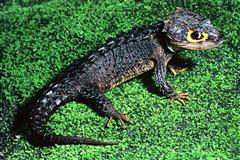Skink - Crocodile
Red Eyed Skink Scientific Name: Trophidophorus grayi
Mon, 28th April, 2025 - 9:23 am GMT
Sponsor Ads:

Alternative Name
Red Eyed Skink Scientific Name: Trophidophorus grayiBasic Info
The Crocodile Skink is small, averaging 7 inches (17 centimeters) in length. They have very spiky scales around the head and down the back and sides. Their head is triangular and their body rather square in shape. They have strong legs with small, clawed toes. The tail is much longer then the body. The Crocodile Skink is different from most other Skinks, which usually have smooth scales.
Health
Ideally, a Crocodile Skink's enclosure would be divided into a land area, including hiding areas, and a shallow pool. The enclosure should have an ambient temperature of between 73 and 77 degrees Fahrenheit, with a warmer basking area in the low to mid 80s. The Crocodile Skink can be fed insects such as mealworms, wax worms, and crickets. They should be fed every other day and given a multivitamin supplement once a week. It is best to always dust insects with a calcium supplement. Breeding The female Crocodile Skink lays between one and four eggs, usually in hidden areas like a nest box. The eggs hatch after about seventy days of incubation at between 76 and 78 degrees Fahrenheit.Habitat
Found in northern Papua New Guinea, northern Irian Jaya, and Karkar Island.Behavior
The Crocodile Skink is an arboreal lizard native to New Guinea. They are unique among skinks because of their spiky bodies. A calm, slow-moving lizard, the Crocodile Skink spends most of its time in trees.The Crocodile Skink can be found in very humid regions such as rainforests. They also live on mountain ridges at moderately low elevation. They prefer areas with relative humidity of 95 to 100% that receive at least eight feet of rain per year. They live in the cooler regions of the rainforests, where the temperatures are between 62 and 80 degrees Fahrenheit (16 to 27 degrees Celsius).Origin
Indo-PacificHistory
In the wild, the Crocodile Skink can be found in northern Papua New Guinea, northern Irian Jaya, and Karkar Island.Common Foods
They are omnivorous, feeding primarily on snails and insects but also on flowers and fruits.Sponsor Ads:
Who wooed in haste, and means to wed at leisure. The Taming of the ShrewAct iii. Scene 2, William Shakespeare
Skink - Crocodile
Coded by: BGID® | ALL RIGHTS RESERVED Copyright © 2000-2025
Disclaimer | Privacy | Report Errors / Contact | Credits








 Why haven't we as a collective earth met with aliens yet?
Why haven't we as a collective earth met with aliens yet?  The Best Text Adventure You Will Ever Play! The official site:
The Best Text Adventure You Will Ever Play! The official site:  Homosexual behavior stems from the mind or genetics?
Homosexual behavior stems from the mind or genetics?  World EcoSystem - Biodiversity Changes - Who is on board and who isn
World EcoSystem - Biodiversity Changes - Who is on board and who isn  Mouthwash - Mouthrinse - Mouth Sores - Healing Infections - Gingivitis
Mouthwash - Mouthrinse - Mouth Sores - Healing Infections - Gingivitis  Treatment for Depression
Treatment for Depression  Ultra radical and violent Islamist group that even rivals Al Qaeda
Ultra radical and violent Islamist group that even rivals Al Qaeda  An idea to have teachers who want to carry guns to school undergo some level of police training will be left up to local school districts and police departments.
An idea to have teachers who want to carry guns to school undergo some level of police training will be left up to local school districts and police departments.